The Google display network (GDN) is the largest and most commonly used contextual online advertising network available today.
Despite having a reported reach of over 80% of global internet users, it is somewhat under-utilized by search marketers in favor of bottom of the funnel PPC tactics to generate more last-interaction conversions.
This post will outline the common use cases and targeting options for GDN, upper-funnel attribution problems and detail key metrics you should be using to put a business case together for full-funnel GDN investment and measure the success of your display network activity.
Why Use The Google Display Network?
The Google Display Network has numerous advertising features, formats, and targeting options. Arguably the most commonly used approach on the GDN is remarketing activity.
Remarketing enables you to display ads to users who’ve previously visited your website. Users will be served ads whenever they are browsing sites on the Google Display Network, which includes YouTube. Remarketing typically offers a lower CPA than search network activity and is a great bottom of the funnel conversion tool as people seeing your ads are already familiar with your brand.
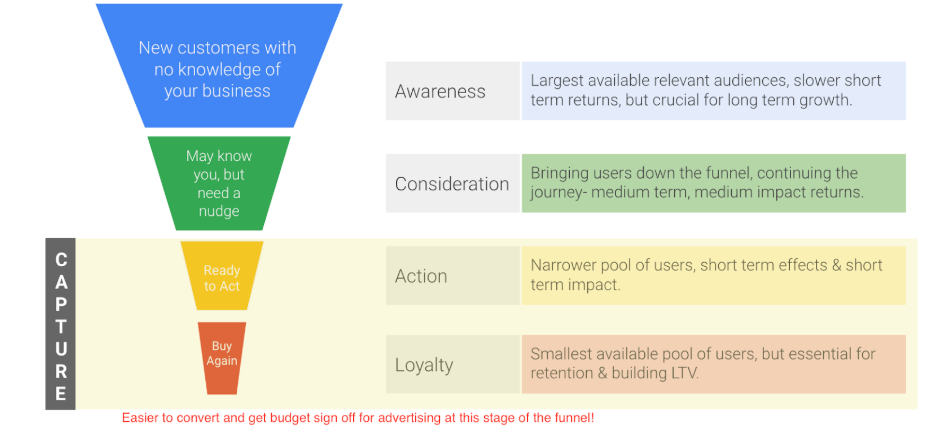 Remarketing is a commonly used bottom of the funnel GDN tacticFor marketers judged on generating a return on advertising spend, it is tempting to solely focus display spend on bottom-of-the-funnel tactics such as remarketing to generate last-interaction conversions. However, upper-funnel display advertising is vital to sustainable growth.
Remarketing is a commonly used bottom of the funnel GDN tacticFor marketers judged on generating a return on advertising spend, it is tempting to solely focus display spend on bottom-of-the-funnel tactics such as remarketing to generate last-interaction conversions. However, upper-funnel display advertising is vital to sustainable growth.
Unlike remarketing, upper-funnel display advertising is the concept of targeting users before they are aware of your product through display; this requires a creative approach to marketing messaging to encourage potential customers to take note of your brand.
 Upper-funnel display activity is designed to boost brand awareness and consideration
Upper-funnel display activity is designed to boost brand awareness and consideration
When done right, targeted awareness ads on the Google Display Network will place your brand in front of ideal customers before they are even looking for your product or service, giving you an edge on your competition in terms of brand recall before the user has even considered their options.
 Example banner advertisement served on the GDN
Example banner advertisement served on the GDN
The impact of display network advertising is notoriously difficult to measure, as its influence can be likened to subliminal messaging (see divided attention theory). This theory suggests that we subliminally take in things around us even if distracted by something else at the time, meaning that people who are served your display ads will likely remember them even if they didn’t directly focus on them at the time.
As we will go on to cover, the fact many marketers still rely on last-click attribution models means that in many cases display activity won’t be getting the credit it deserves for helping push users further down the purchase funnel.
Tactics to Boost Display Network Performance
To get the strongest return on your display advertising investment, you will need to utilize the targeting options available to reach users sharing similar characteristics to your customer personas.
It is absolutely essential that you thoroughly research your audience before commencing any display activity to avoid budget wastage on users who will likely have no interest in your product or service.
Once you have nailed down the characteristics of your potential customers, it is time to set up campaigns to get your message in front of them! Below I have detailed a few tactics you could employ if just starting out with display network activity.
1. Enable Audience Segmentation While Maintaining Reach
If one of your objectives is reach (getting your message to reach as many people as possible), then you shouldn’t add too many layers of targeting to a single ad group. Instead, set up multiple ad groups to modify bids on each targeting combination to enable better reporting and bid modification without limiting your reach.
The default targeting options available on the GDN consist of topics, interests, placements (selected websites), demographic and keyword contextual targeting, and these options can be combined together to better target prospective customers.
Here are some handy combinations to get you started on The Google Display network:
Target Age + Gender + Affinity Audience Category - Similar to interest targeting, affinity targeting will allow you to target ads at users who have a ‘long-term’ interest in a particular topic. Match this with demographic targeting on age and gender to maximize audience relevance.
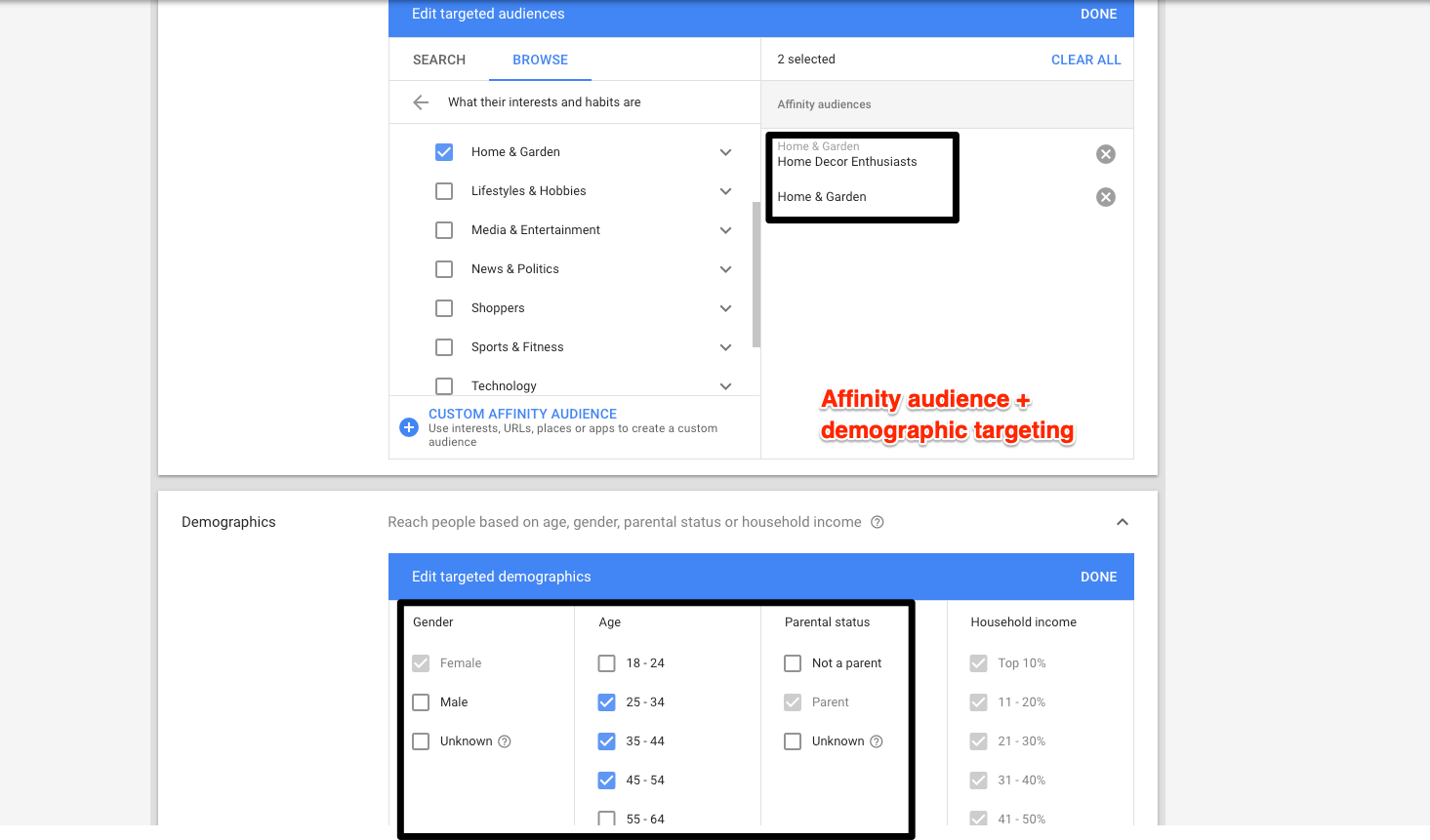 Affinity audience + demographic targeting
Affinity audience + demographic targeting
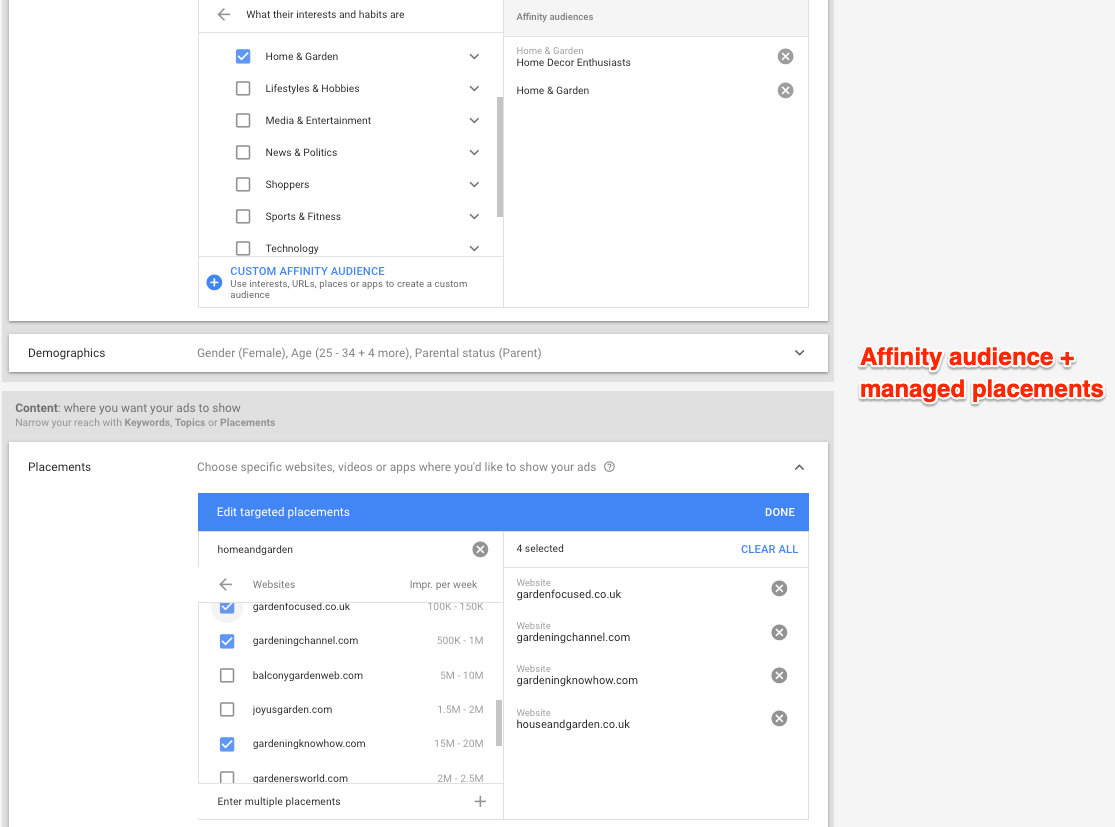 Affinity audience and managed placements
Affinity audience and managed placements
Custom Affinity Audiences - Custom affinity enables you to implement a streamlined version of affinity targeting. Simply select at least five different interests, URLs, places or apps that you feel best describes your audience.
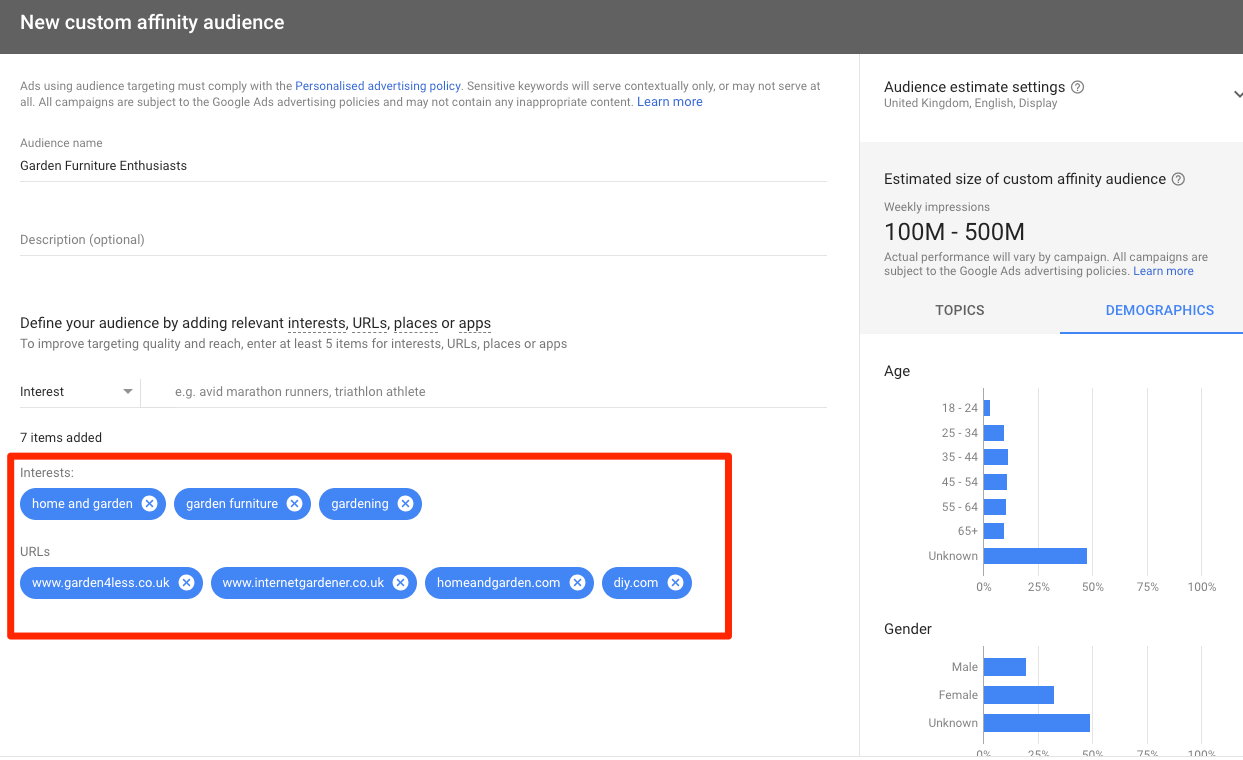 Custom affinity audience
Custom affinity audience
2. Lean on The Power of Similar Audiences
Customer Match gives advertisers the create targeted advertisements and display them to their customers or prospects whenever they are browsing YouTube, Gmail or using Google Search. While not available on the display network, your customer lists can be used to discover new prospects with similar characteristics through Google’s similar audience feature.
Similar audiences can also be set up based on standard audience lists you have imported into your Google Ads account and are a great way of targeting ads at users sharing similar characteristics to your existing website visitors and existing customers to expand your reach on the GDN.
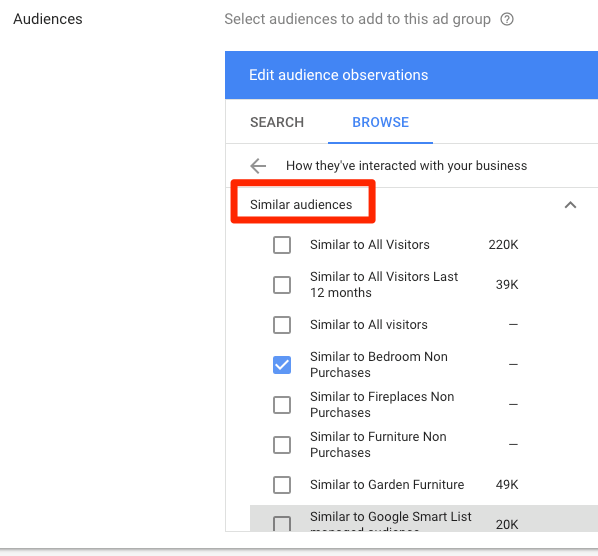 Similar audiences in Google Ads audience manager
Similar audiences in Google Ads audience manager
Similar audiences allow you to increase the reach of your campaigns to drive new users to your site who have similar browsing habits as previous website visitors or customers.
Be sure to segment similar audiences into separate ad groups to monitor relative performance and modify bids accordingly.
3. Use Display Exclusion Lists
Regularly reviewing the placements where your ads are being served is essential in spotting budget wastage. There are certain placements that always tend to soak up a chunk of budget if not managed proactively, and a lot of this wastage could be avoided by using display exclusion lists.
If you aren’t using managed placements and haven't checked where your ads have been appearing recently, chances are mobile games are wasting a significant chunk of your budget.
To check where your ads have been appearing you will need to visit the placements tab within selected campaigns. There you can filter by ‘mobile app’ to see which apps your ads have been appearing within.
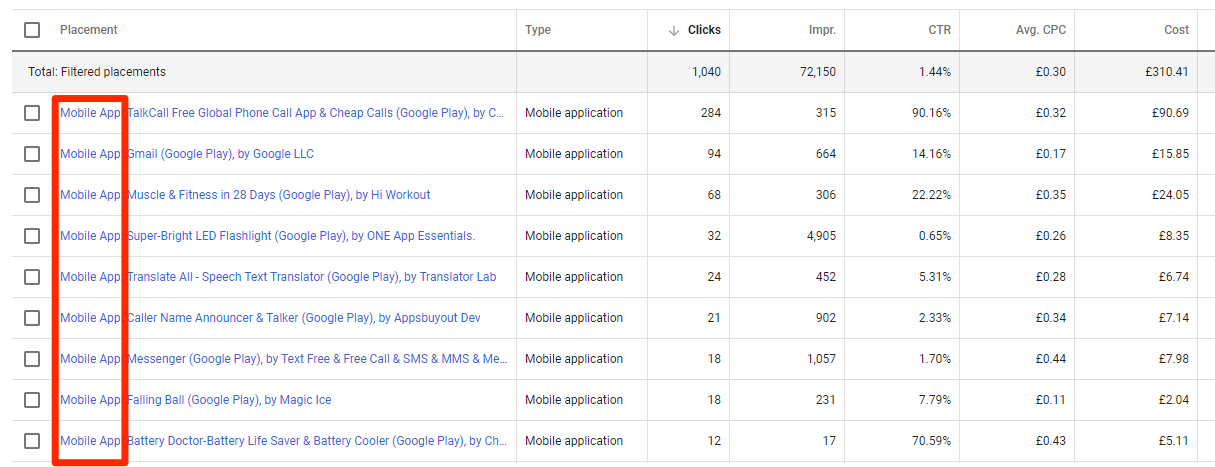 Mobile games featuring in the placements report
Mobile games featuring in the placements report
In addition to excluding mobile games from your display campaigns, I would also be pretty ruthless about excluding mobile apps more generally from taking up too much budget as I have never seen much evidence of their effectiveness in achieving overall campaign objectives.
4. Test In-Market Audiences
In-market audiences are users Google deems to be ‘ready to buy’ (or ‘in the market’ for X) a particular product or service; this audience should be a desirable target as they are actively on the hunt for products and services matching what you have to offer.
To set up in-market targeting, select ‘interests and remarketing‘ when setting targeting options and select ‘in market audience’. There you will be presented with the in-market categories Google have to offer.
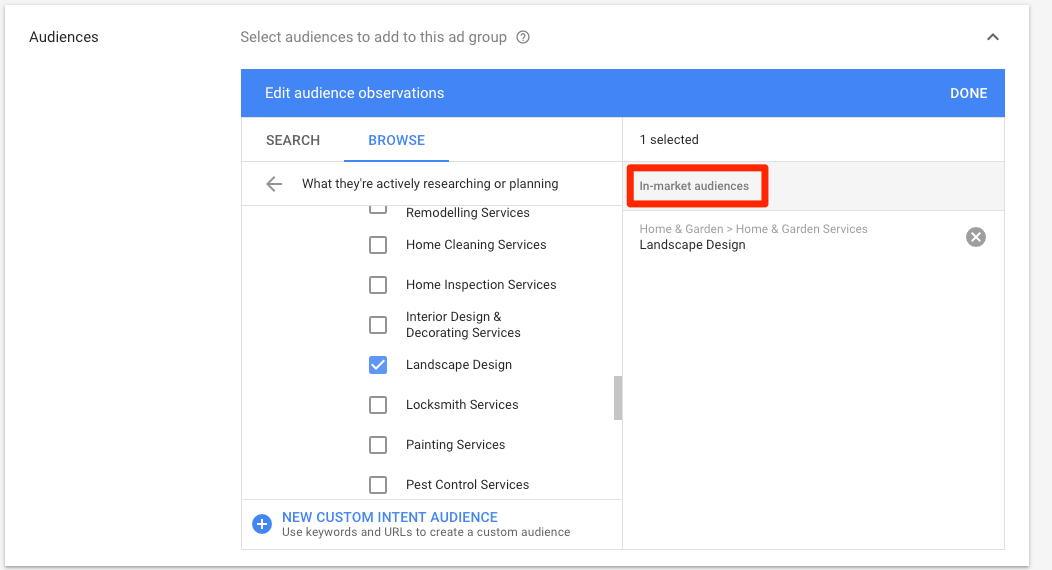 In market audience selection
In market audience selection
For those advertisers wanting to really zone in on a specific audience intention, Google offers ‘custom intent’ targeting, which you can set up to mimic the characteristics of an in-market audience not covered by the default options available.
For example, you could create a custom intent audience by building a bank of bottom-of-the-funnel keywords, URLs and apps to represent what being ‘in-market’ looks like for the audience you have in mind.
5. Try Responsive Display Ads
Launched back in 2016, responsive display ads can save advertisers time by allowing Google to automatically create and test different combinations of core display ad elements.
An alternative to manually creating creative for every available ad slot, responsive display ads require advertisers to input a variety of headlines, images, descriptions, and logos with the aim of Google displaying the best-performing combination.
 A responsive display ad in the wild!
A responsive display ad in the wild!
When setting up responsive display campaigns, you can add up to:
15 images 5 headlines 5 descriptions 5 logosThese assets will then be combined and automatically adjusted to fit different ad placements across the GDN.
The benefits of responsive display include:
Broader Reach - Google will work with the assets you provide to ensure they are optimized for every available ad slot on the GDN.
Time Savings - Reduces overhead on creative team management of ads.
Automated Ad Optimization - Google uses machine learning models to determine the perfect combination of assets in any ad they serve, something humans simply aren’t capable of replicating within the same timeframe.
How to Measure Display Network Activity
Aside from remarketing, display advertising activity often won't result in a direct conversion, and so it shouldn’t be measured strictly on last-interaction conversion actions.
The measures of success for a display campaign can be split into 3 categories:
Brand Awareness
Ad Engagement
Direct Response
Performance metrics you should be using to judge the success in each category are listed below.
Brand Awareness Metrics
Increases in branded search activity resulting from display campaigns can be monitored in Google Analytics. Annotations can be used to highlight dates in which display campaigns were set up to ensure this can be measured.
The number of new users visiting your website is a good measure of how successful your display campaigns have been in increasing brand awareness and overall website traffic.
Impressions are commonly used as an awareness measure of how many times your ads have been served to targeted users. However, I would recommend paying more attention to viewable impressions based on view rate metrics.
Engagement Metrics
Engagement metrics are perhaps more important on YouTube than GDN. However, if you wanted to measure interaction with your display advertisements, this can be achieved through metrics such as:
Engagements - whenever a user taps, clicks or expands your lightbox ads.
Clicks - clicks through to your website from your display ads.
Direct Response Metrics
The PPC metrics that tend to gain most attention from C-suite, and rightly so. Direct response measures include the desired conversion actions taken whenever your ads have been served.
Reporting on view through conversions is often under-utilized in favor of direct conversions. However, it will help you measure the contribution of display advertising by reporting where a user has viewed a display ad and later converted via another channel.
Assisted conversion value should also be used to monitor the number of times and the associated value where display activity was involved in the path to conversion; this will attribute a portion of conversion value to display activity when people have clicked on an ad and later converted through another channel.
Conclusion
Attribution is still a huge challenge for marketers, especially when it comes to display advertising. Many marketers still tend to focus on measuring direct response from display ads, but fail to measure the effectiveness of upper-funnel display advertising.
If display ads are designed to drive brand awareness and a minuscule percentage of users ever click these ads, why are we measuring clicks over viewable impressions? The success of display activity (aside from remarketing) is notoriously tough to measure and makes a business case for future display network spend more difficult to present than a similar case for search network activity.
I have no doubt that display activity can deliver results for any business; the key is setting up appropriate performance measures. By taking the steps outlined in this post to better report and attribute the success of your display network activity, your data will be a much better representation of the value this network is delivering for your business and will generate more actionable insights for future media investments.
Image Credits
Screenshots by Author, March 2019
Innovative SEO services
SEO is a patience game; no secret there. We`ll work with you to develop a Search strategy focused on producing increased traffic rankings in as early as 3-months.
A proven Allinclusive. SEO services for measuring, executing, and optimizing for Search Engine success. We say what we do and do what we say.
Our company as Semrush Agency Partner has designed a search engine optimization service that is both ethical and result-driven. We use the latest tools, strategies, and trends to help you move up in the search engines for the right keywords to get noticed by the right audience.
Today, you can schedule a Discovery call with us about your company needs.
Source:




![Display Advertising Stats 2019: Semrush Study [Fashion Edition]](https://new.allinclusive.agency/uploads/images/display-advertising-stats-2019-semrush-study-fashion-edition.svg)
